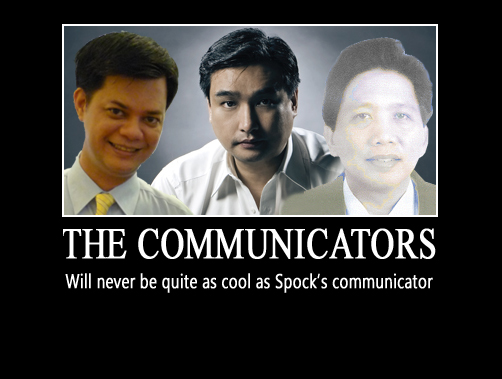It seems like “communication” is the new buzzword in Malakanyang. Aside from the abomination that is “PNoy,” that is. “Communication” (and that’s the last time I’m gonna put it in quotations since you must’ve gotten the point by now) is certainly an improvement on the old speak-through-the-spokesman approach adopted by GMA. Communication implies a two-way street; you talk to us, we talk to you and then maybe we can come to some sort of an agreement on whatever it is we’re talking about.This is the kind of feedback loop that the office of the President seemed to lack, pre-BSA.
Too often, it seemed like GMA had no idea what public sentiment was on an issue. I mean, I get the whole I’m-not-afraid-to-make-unpopular-decisions thinking, but – first, she obviously was because she kept taking things back; and second, being responsive to the pulse of the people avoids generating the sense of disconnectedness with government that directly contributed to the ultimately paralyzing unpopularity of the GMA administration.
In the context of the new President, however, what exactly does he mean his Communications Group to do?
“Sabi ni Pangulo (The President said) he wants an organization that will deliver messages effectively and provide feedback on what the government is doing,” Presidential spokesman Edwin Lacierda said on government-run dzRB radio.
That’s according to a GMAnews.tv report.
While that sounds pretty straightforward, it makes me wonder why the emphasis on “messages” is very obvious. Even in the ordinary course of language, a “message” does not necessarily equate with the “unvarnished truth.” And from the office of the President, one would wish to hear nothing but the unvarnished, unspun truth. Statecraft, however, can sometimes turn the obvious on its head.
For instance, it is easily understandable why the Office of the President would find it desirable to have the infrastructure ready to “craft the message” – supposedly Ricky Carandang’s primary assignment –
However, a source close to the President confirmed the designation of the three men to the Palace communications team. He said Carandang and Quezon would be in charge of “messaging” and Coloma, “dissemination.”
presumably before it is unleashed upon the people, courtesy of Herminio Coloma. Obviously, not all information can be released raw. I mean, how would it serve the administration if all it said was “Pump prices will go up by 5 centavos tomorrow at midnight?” Certainly, that information has to be contextualized before it is even released. “In light of recent movements in the international market, pump prices will go up by 5 centavos tomorrow at midnight.” See the difference?
With the first, people who hear that announcement will be left to speculate as to the reasons why their life has suddenly gotten that much harder. Inevitably, government will be criticized. But with the second formulation, it’s not the government that can be blamed; CLEARLY, it’s the oil price fluctuations in the international markets ! Since the “message” is released this way then, there will be a greater chance that it will appear in the news contextualized exactly like that. That’s what “messaging” means.

As a fortunate side-effect, the few news outlets that do release the bare fact of an increase in pump prices can then easily be labeled fringe critics, or cat’s paws for die hard political enemies. And of course, once that label has been assigned, it’ll stick and it’ll be possible – even easy – for ordinary news consumers to ignore those news outlets.
In a limited way, this is exactly what happened with Bro. Armin Luistro.
Like it or not, Armin Luistro telling the media they were of no help at all was exactly what Armin Luistro felt and meant. That he is able to speak more diplomatically now – thanks to a media management seminar – only means that he has learned to draw the curtains across the window into his mind. It doesn’t necessarily change what he thinks or how he feels; he’s just gotten smoother at talking into microphones. The same, obviously, goes for all the other government officials that are going to be sent to a similar seminar to be taught how to “handle the media.”
On a tangential note, it might be an excellent gauge of how sweet this honeymoon is that no one in media has raised a howl at the prospect of being “handled.” I raised this point with a reporter friend and she said maybe it was because media was made to feel important by that directive. “It felt good to have that sort of recognition from the President,” she said. I don’t know. Maybe I’m behind the times, but the idea that media can be handled is not something the media should be comfortable with because the implication is you’re not gonna get the ugly truth but the polished version. Or, as the President himself apparently said:
“We want to engage the people in the agenda that we have and that the best way is through you,” the President declared, adding that it was the best way to communicate government plans and programs for greater public appreciation.
This is actually a common refrain among government officials eager to deflect criticism in the media. Who knows? Maybe when it’s the President that woos the media into becoming the government’s PR arm, maybe it’ll make all the other unpleasantness-es go away.
Because that’s what this whole idea of a ‘communications group’ seems to boil down to, what with the emphasis on a newsman being in charge of messaging: that “government plans and programs” would be communicated to the people with a view to “greater public appreciation.” And that’s pretty much what you want to happen when you hire a PR firm. You want to make sure that the public appreciates the best parts of your plan and hopefully won’t think too much about the other bits.
Kinda like saying “sa totoo lang.“

